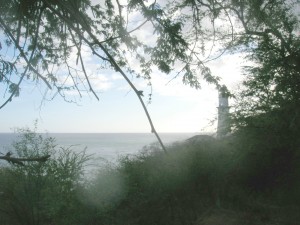July 24th, 21:15 utc – lat 22 37 N, lon 149 55 W
Start with the end in mind, but the journey has to be the reward. In our case, the end is the finish line by Diamond Head lighthouse. The Journey, well that’s some of the best sailing that I have ever done. Squalls are building quickly this afternoon. The fleet is really spread around the race course. We like our position in the center of the race course, away from the laylines, as it gives us the most flexibility in our squall riding experiments. We’re in a good routine now that includes watches, organized sleep, meals, navigation, celestial sights, weather crunching, steering, trimming and, very importantly, jibing. At first, this all seemed a daunting task – something that 15 people on a TP-52 do. And now, just the two of us are doing it all in a very organized way.
For you OceanGizmo readers, the laptop that we use on-board is a Panasonic semi-rugged Toughbook. The kind of software that we use for sensors and monitoring does not run on Macs. So we run Windows Vista. There were many skeptics when I decided to go with Windows Vista instead of XP. However Microsoft has been very cooperative and has welcomed our sensor and monitoring systems working in real-time. We got the whole package to work. It wasn’t easy, but we did. The Panasonic laptop is very reliable, very conservative in it’s architecture and extremely efficient at power management. We picked the new CF-Y7 because it is so efficient. It’s presently a Japanese model and I am typing on a Kanji keyboard (which is a bit of a practical joke and pretty funny really) coupled with a Logitech Trackball. We get everything that we need: two USB ports, a CAT-5 connection, PC Card slot, SD card slot, and a DVD player/burner that opens from the top (a great feature). We carry a spare Toughbook in case this one fails. Since we started, the system has been up 24/7 and worked flawlessly. In fact, I settled on it after seeing a piece online on Gizmodo.
